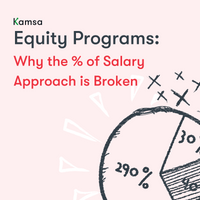
Equity Programs: Why the % of Salary Approach is Broken
When offering stock options to employees, some companies consider establishing equity guidelines based on a percentage of salary. This formula seems straightforward and easy to administer, but using a percentage of salary by job level can actually create more problems than it solves for most organizations.
Here's why we don't recommend using % of salary for equity grant guidelines:
- Inequities and inconsistencies
Imagine two employees in the same job with the same skills and experience level, but one negotiated a higher salary. Under the % of salary equity approach, the employee who negotiated a higher salary automatically also receives a higher stock options grant.
This approach can lead to unconscious bias and inconsistent offers despite both employees being in a job that brings similar impact to the organization. - Budgeting challenges
Most organizations need to balance prioritizing the impact of their equity budget (e.g., dilution rate) while ensuring the grants offered are aligned to the competitive market. Managing and predicting the number of shares needed for the year becomes more difficult with the % of salary equity method, as the salary market is different from the equity market, where salaries often have greater fluctuations. Also, the % of salary approach to establishing equity grant guidelines has the potential to shift an organization away from market equity competitiveness, and unnecessarily drain the equity pool. - Administrative burden
With a % of salary equity approach, inconsistencies can quickly compound, and become harder to manage over time. As organizations grow, they need to account for scalability and predictability in their equity approach. Overtime, the % of salary equity method only has potential to be consistent and easy to administer if the organization strictly adheres to a ‘no salary negotiation’ policy, which is uncommon.
A Better Way: Kamsa's Equity Model
Kamsa presents a smarter and fairer approach to equity, built on:
- Proprietary Market Equity Data
We collect data from our clients and meticulously analyze it to create accurate and up-to-date benchmarks specifically for equity grants. This ensures your equity program is competitive and attracts top talent, while remaining a responsible custodian of your company’s resources and budget. - Scalable Equity Guidelines
Instead of relying on a % of salary, we provide clear guidelines for the number of shares each job category and respective job level should receive. Kamsa’s straightforward guidelines for new hires, refresh, and promotion grants simplifies administration and supports your company's need for scalability. - Insightful Equity Decisions
Our Equity Model removes guesswork by pairing market data with your company's specific data (e.g., 409A valuation, options pool, countries your employees are in). You’ll be equipped to better predict your equity needs for the future.
Once you’ve established equity guidelines and budget, Kamsa’s Equity Review tool allows for painlessly administering refresh and promotion grants so you can reward employees’ performance and ensure they feel valued.
When companies use the % of salary approach to granting equity, they are susceptible to unconscious bias. Kamsa’s equity market data approach ensures fairness and competitiveness against the market in which you compete for talent.
Kamsa offers companies with the following:
-
Accurate market data: Our proprietary market equity data ensures your grants are competitive for each role and level.
-
Budgeting made easy: Kamsa's Equity Model automatically calculates grant amounts based on your company's specific data, eliminating manual calculations and inconsistencies.
-
Tailored solutions: Our solutions factor in your company's specific situation, estimated per share value, and employee performance into account.
-
Fair equity program: Kamsa's equity review tool helps distribute available shares based on predefined criteria, ensuring fairness and transparency.
About Kamsa
Kamsa has helped over 500 companies, globally, with their equity compensation programs. Kamsa’s Equity Model calculates estimated shares needed for the year and respective dilution rate based on headcount, estimated per share value, and the company’s budget/pool.


